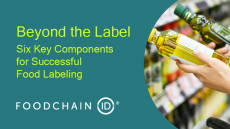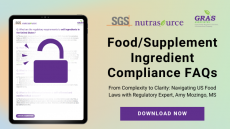FDA pushes for progress in sodium reduction target, aims to cut average intake to 2,750 mg/day

FDA aims to gradually reduce Americans’ sodium intake from the phase one target of 3,400 mg per day set in 2021, with a longer-term goal of 2,300 mg per day for individuals aged 14 and older.
This phased approach allows consumers to adjust to flavor shifts over time, Robin McKinnon, senior advisory for nutrition policy, Center for Food Safety and Applied Nutrition, FDA, explained during the agency’s update to the draft guidance in its webinar yesterday.
The guidance document for food manufacturers and food service operators outlines two types of sodium reduction targets: a sales-weighted mean target for food categories and an upper bound target for individual products. The targets are based on food safety, food technology, marketplace data and other information, McKinnon said.
FDA’s guidance covers 163 food categories, setting specific sodium targets per 100 grams for each, and will be revisited every three years. These categories range from common items like cheese to bread, explained Kasey Heintz, nutrition scientist, Office of Food Additive Safety, CFSAN, FDA.
Packaged food industry has seen varied but improved progress in sodium reduction levels
The change in sodium levels between 2010 and 2022 were promising, McKinnon said.
FDA found that across categories which includes 300 products, the 2010 baseline sodium level dropped from 496 mg/100g to 462 mg/100g by 2022. This reduction indicates a positive shift in sodium levels, with more products now falling within lower sodium concentration ranges, McKinnon explained.
From 2010 to 2022, 62% of food categories reduced sodium, 25% increased sodium levels and 13% showed no change, Heintz added.
Most notably, toddler and baby food saw a 100% decrease in sodium levels — a promising sign for early taste pallet adjustment to lower sodium diets, Heintz said.
Sodium’s role in food preservation, flavor and texture are critical, and the targets are tailored based on food categories. For example, sodium draft targets for cheese were barely changed because sodium is a key component in managing microbial safety, stability and other functions, Heintz added.
Sodium reduction addresses a public health issue
In the US, the average sodium content in foods is 714 mg/100g, which is higher than countries like the UK and Canada where voluntary targets have proven successful, Heintz said.
Sodium overconsumption is a public health issue, with 100 million Americans living with high blood pressure, McKinnon explained. African Americans are disproportionately affected, being 60% more likely to be diagnosed, “so moving the needle here in supporting reductions in sodium intake can broadly improve population health,” she said.





















